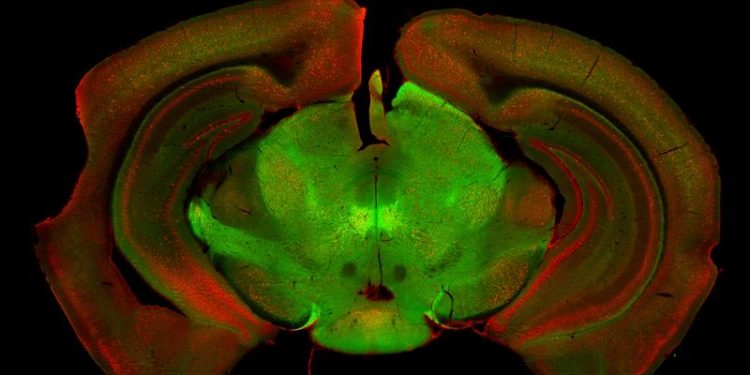Relay station in the brain controls our movements

Two cell populations in the substantia nigra that are responsible for different aspects of locomotion. Image: University of Basel, Biozentrum
Whether we move our arms, legs or the entire body, every movement is centrally controlled by our brain. Different brain regions and neuronal networks play an essential role in this process. This includes the substantia nigra, which has been minimally investigated so far.
Like a relay station, this region receives and distributes signals in order to appropriately orchestrate the execution of a desired movement. Using a mouse model, Prof. Kelly Tan's research group at the Biozentrum, University of Basel, has now identified two cell populations in the substantia nigra that are responsible for different aspects of locomotion.
Correct movement thanks to teamwork of neuron populations
The research team investigated the substantia nigra anatomically, genetically and functionally. It became apparent that this region consists of several different types of nerve cells.
The researchers could identify two of the populations and describe them in more detail. While one population is responsible for initiating a motor task, the second population ensures the continuity of the desired movement.
“The heterogeneity of neuronal populations in the brain, also in the substantia nigra, is a well acknowledged concept. In our study, not only we decipher the function of two nerve cell groups, but we also show that they work together to produce correct locomotion,” says Giorgio Rizzi, first author of the study.
Signals for movement control are interrupted in Parkinson’s disease
The findings of the study are also important in regard to Parkinson’s disease. Patients suffer from motor control abnormalities because certain nerve cells degenerate.
“Interestingly these cells are interaction partners of the population we identify as essential for movement initiation. This means that the signals of the cell population are no longer received and transmitted; and this dysfunction may underlie the movement initiation impairment symptom observed in Parkinson’s disease patients,” says Kelly Tan.
In the future, the research team aims to continue identifying other cell populations of the substantia nigra and elucidate their motor functions. “With regard to Parkinson's disease, we will assess how each network is altered as a result of the disease and how this affects movement.
If we understand the circuit modifications, we may find a way to tackle this neurodegenerative disorder and relieve the symptoms of Parkinson's disease patients,” states Kelly Tan.
Prof. Dr. Kelly Tan, University of Basel, Biozentrum, Tel. +41 61 207 16 26, email: kelly.tan@unibas.ch
Giorgio Rizzi and Kelly R. Tan
Synergistic Nigral Output Pathways Shape Movement
Cell Reports (2019), doi: 10.1016/j.celrep.2019.04.068
https://www.cell.com/cell-reports/fulltext/S2211-1247(19)30541-8
Media Contact
More Information:
http://www.unibas.chAll latest news from the category: Life Sciences and Chemistry
Articles and reports from the Life Sciences and chemistry area deal with applied and basic research into modern biology, chemistry and human medicine.
Valuable information can be found on a range of life sciences fields including bacteriology, biochemistry, bionics, bioinformatics, biophysics, biotechnology, genetics, geobotany, human biology, marine biology, microbiology, molecular biology, cellular biology, zoology, bioinorganic chemistry, microchemistry and environmental chemistry.
Newest articles

NASA: Mystery of life’s handedness deepens
The mystery of why life uses molecules with specific orientations has deepened with a NASA-funded discovery that RNA — a key molecule thought to have potentially held the instructions for…

What are the effects of historic lithium mining on water quality?
Study reveals low levels of common contaminants but high levels of other elements in waters associated with an abandoned lithium mine. Lithium ore and mining waste from a historic lithium…

Quantum-inspired design boosts efficiency of heat-to-electricity conversion
Rice engineers take unconventional route to improving thermophotovoltaic systems. Researchers at Rice University have found a new way to improve a key element of thermophotovoltaic (TPV) systems, which convert heat…



